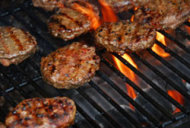Planning a Father's Day barbeque this Sunday?
Throwing a few steaks and burgers on the grill, you might have noticed, has gotten more expensive as the cost of beef has climbed over the past year. And it's only going higher, say economists.

The average retail price of beef from January through April this year is 7.7% higher than the same period a year ago, according to the USDA's Economic Research Service data, while it's remained steady over the past few months, says John Michael Riley, an assistant professor in Mississippi State University's department of agricultural economics. And the average price in 2011 was 9.8% higher than in 2010.
Higher Prices Will Continue
Shoppers are going to continue to see higher prices at the meat counter — and not just for beef. Chris Hurt, a professor of agricultural economics at Purdue University, says he expects the average price of beef to rise to about $5.30 a pound next year. So far this year through May, retail prices have averaged $5.03 a pound — a record high for this time period (it was $4.72 a pound for January-May 2011 and $4.83 for all of 2011). The latest Consumer Price Index for all food is projected to increase 2.5% to 3.5% in 2012.
Two main factors have contributed to the rise: a drought that devastated parts of the U.S. last year and a shrinking supply of cattle.
The extreme drought states such as Texas, Oklahoma and New Mexico suffered last year forced ranchers "to liquidate a lot of cattle," says John D. Anderson, senior economist at the American Farm Bureau Federation. That's brought production down, which means less available beef and therefore higher prices, he says. In fact, beef cow numbers today are at 29.9 million head in the U.S., down 9% from 2006, says Hurt.
Another reason behind smaller cattle herds, says Riley, is higher costs for feed and fuel, as well as higher capital costs to enter the business.
Americans Eating Less Meat
Tied to the decrease in production is the fact that Americans have been eating less meat — 55.7 pounds of beef this year compared to 65.8 pounds in 2006, a 10-pound-per-person drop, says Hurt. Meanwhile, foreign consumption of U.S. beef has increased since then, due in part to the relative weakness of the U.S. dollar vs. various other currencies. That means American consumers have more competition for limited supply of the stuff, he says.
The rising price of beef, along with the panic caused by the "pink slime" episode earlier this year, has forced some restaurants to favor chicken over beef when it comes to menu options. According to a May report by market research firm Mintel, the number of menu items with poultry as an ingredient has climbed an average of 12% in the past three years and is expected to continue to rise in the next one to two years (see: McDonald's Chicken McBites, Whataburger's Whatachick'n Bites and White Castle's Chicken Rings).
So when will beef get some price relief? The short answer is not for a while. The beef industry has a long production lag — about two to three years — so it will take a few years for shoppers to see results in the grocery store, says Riley.
Ranchers, though, are beginning the process of getting their pastures back in shape and expanding their herds, says Jeff Stolle of the Nebraska Cattlemen, a trade group. "But this cannot and will not happen without Mother Nature's cooperation."








